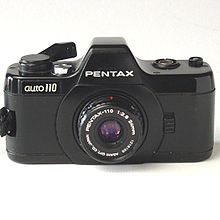Rare Find!!! Insanely clean, Made In Japan
Very clean, looks unused and stored in perfect condition. Tiny 110 film format SLR!
Camera body even still has original plastic protection. Original manual included.
New internal batteries were inserted and the light meter in the viewfinder does work!
Lenses (I assume they are labeled in the 35mm equivelant) :
- 2.8 - 18mm
- 2.8 - 24mm
- 2.8 - 50mm
The Pentax Auto 110 and Pentax Auto 110 Super were fully automatic single-lens reflex cameras manufactured by Asahi Pentax for use with Kodak 110 film cartridges.[1] The Auto 110 was introduced with three interchangeable, fixed focal length lenses in 1978. A further three lenses (including one zoom lens) were added in 1981 to coincide with the release of the Auto 110 Super the following year. The camera system was sold until 1985. The complete system is sometimes known as the Pentax System 10, apparently for its official Pentax name, although most Pentax advertising only uses the camera name or Pentax-110. This model represented the only complete ultraminiature SLR system manufactured for the 110 film format, although several fixed-lens 110 SLRs were sold. The camera system also claims to be the smallest interchangeable-lens SLR system ever created.
The cameras and lenses were very small (the camera fits in the palm of a hand easily).
Auto 110
 Asahi Pentax Auto 110
Asahi Pentax Auto 110The Pentax Auto 110 features fully automatic exposure, with no user-settable exposure compensation or adjustments. Metering is TTL (through-the-lens) and center-weighted. Unlike 35 mm SLRs, the system's lenses do not have a built-in iris to control the aperture. Instead, an iris is mounted inside the camera body, and functions as both an aperture control and a shutter. This mechanism is capable of programmed exposures between 1/750 s at f/13.5; and 1 s at f/2.8. To ensure that light travelling past the diaphragm blades could not get through to the film over time, the camera's mirror system also functions as a light-tight seal when in the viewing and focusing position. Since the iris is part of the camera, all of the system's lenses had to be constructed with an f/2.8 aperture. The lens' designs, based upon the film dimensions, result in the 24 mm lens being the 'normal' focal length (i.e. equivalent angle of view to a 50 mm lens on a 135 format camera), while lenses of wider angles or longer focal lengths were larger.